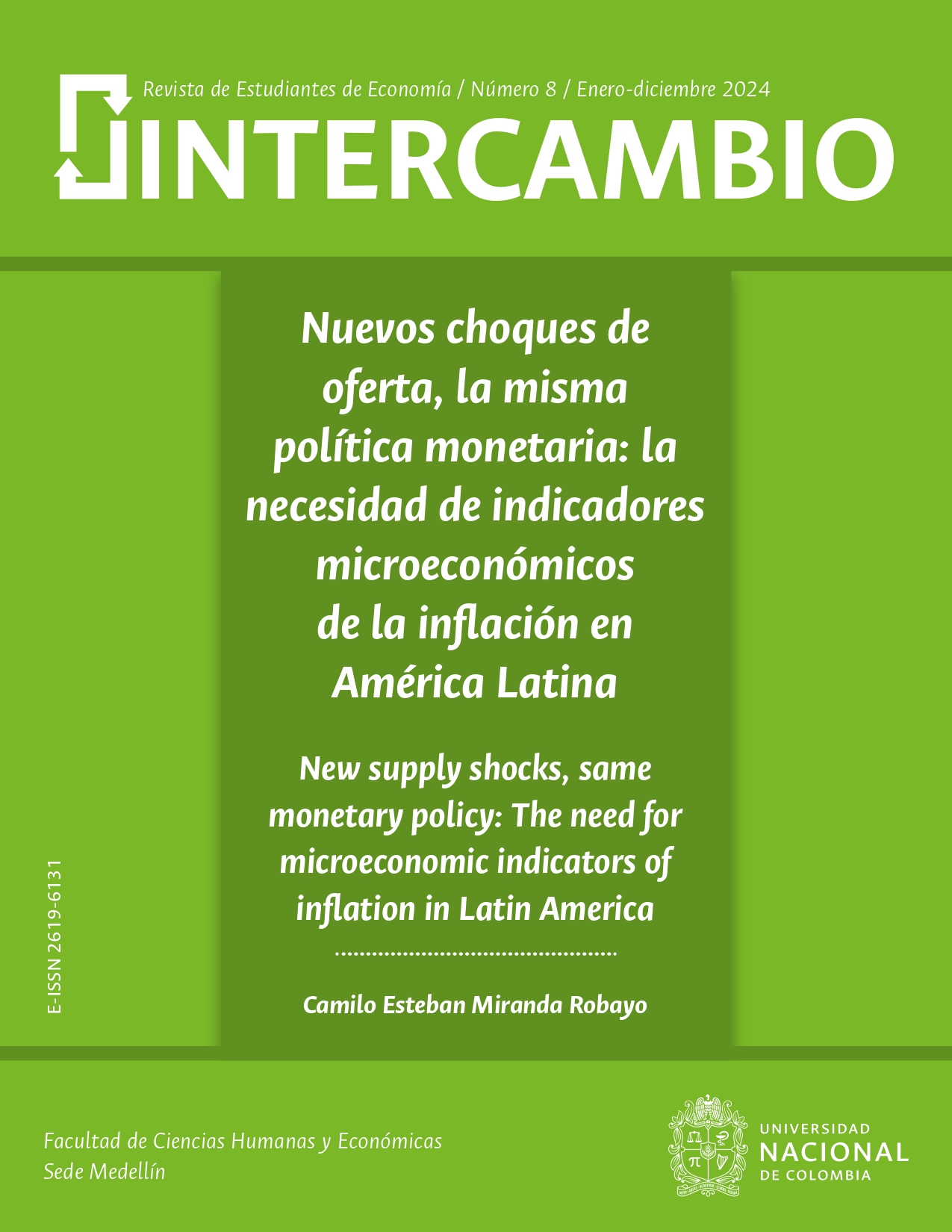New supply shocks, same monetary policy: The need for microeconomic indicators of inflation in Latin America
Keywords:
microeconomic data, supply shocks, inflation decomposition, seller’s inflation, Latin AmericaAbstract
Since 2021, Latin America has experienced inflationary phenomena to which Central Banks have responded using their inflation targeting frameworks. However, the fact that the main drivers of these price increases may have been supply shocks not only calls into question the effectiveness of measures such as interest rate hikes but also revives the debate on their negative impacts on the productive fabric and the functional distribution of income. In this context, this paper argues for the need for macroeconomic indicators to measure and decompose inflationary impulses in the region, which would enable monetary authorities to differentiate their policy strategies in response to price level changes originating from asymmetric sources. Data from Mexico, Colombia, Brazil, Chile, Paraguay, and Peru are analyzed, concluding that there do not appear to be nuances in the interest rate reactions of the region’s central banks regarding the origin of inflation.
References
Bénassy, J. (2011). Employment targeting. Paris-Jourdan Sciences Economiques. Working Paper No. 2006-20. https://hal.science/PJSE_WP/halshs-00590456v1
Camacho, F., & Gonzáles, J. (2020). Política monetaria y choques de oferta: El fin del super-ciclo de commodities en América Latina. Revista de Economía de Centroamérica y República Dominicana, Volumen I. https://www.secmca.org/recard/index.php/recard/article/view/164#:~
Firat, M., & Hao, O. (2023). Demand vs. Supply Decomposition of Inflation: Cross-Country Evidence with Applications. IMF Working Papers. https://www.imf.org/en/Publications/WP/Issues/2023/09/28/Demand-vs-539665
Fondo Latinoamericano de Reservas [FLAR]. (2024). Sistema de Información Económica - SIE. https://flar.com/sie/
Fornaro, L., & Martin, W. (2023). The scars of supply shocks: Implications for monetary policy. Journal of Monetary Economics, 140(Supplement). https://www.sciencedirect.com/science/article/pii/S0304393223000417
Hansen, N. (2023). Euro Area Inflation after the Pandemic and Energy Shock: Import Prices, Profits and Wages. IMF Working Papers. https://www.imf.org/en/Publications/WP/Issues/2023/06/23/Euro-Area-Inflation-after-the-Pandemic-and-Energy-Shock-Import-Prices-Profits-and-Wages-534837
Lane, P. (2023, March 6). Underlying inflation. Lecture by Philip R. Lane, Member of the Executive Board of the ECB, Trinity College Dublin. https://www.ecb.europa.eu/press/key/date/2023/html/ecb.sp230306~57f17143da.en.html
Lerner. A. (1960). On Generalizing the General Theory. The American Economic Review. 5091), 121-143. https://www.jstor.org/stable/1813464
New York Times. (2020, April 21). What the Negative Price of Oil Is Telling Us. https://www.nytimes.com/2020/04/21/upshot/negative-oil-price.html
Ocampo, J., & Ojeda-Joya, J. (2022). Supply shocks and monetary policy responses in emerging economies. Latin American Journal of Central Banking, 3(4). https://www.sciencedirect.com/science/article/pii/S2666143822000254
Organización para la Cooperación y el Desarrollo Económicos [OCDE]. (2023). OECD Economic Outlook, 2023(1). https://www.oecd-ilibrary.org/economics/oecd-economic-outlook/volume-2023/issue-1_ce188438-en
Salazar, J., Osorio, C., Santaella, J., Rivera, V., Rivera, S., Castañeda, F., Herrera, J., & Sánchez, S. (2024). Seller’s inflation en Colombia. Notas Macroeconómicas. Dirección General de Política Macroeconómica, Ministerio de Hacienda y Crédito Público. https://www.minhacienda.gov.co/webcenter/ShowProperty?nodeId=/ConexionContent/WCC_CLUSTER-236235
Schewerhoff, G., & Sy, M. (2014). The non-monetary side of the global disinflation. Oven Economic Review, 25, 337-371. https://link.springer.com/article/10.1007/s11079-013-9283-7
Shapiro, A. (2022). How Much Do Supply and Demand Drive Inflation? Research from the Federal Reserve Bank of San Francisco. https://www.frbsf.org/wp-content/uploads/el2022-15.pdf
Shapiro, A. (2024). Decomposing Supply and Demand Driven Inflation (Working Paper 2022-18). Federal Reserve Bank of San Francisco. https://doi.org/10.24148/wp2022-18
Toboada, B., & Villamizar, M. (2024). La reacción óptima de la política monetaria ante choques de oferta y la coordinación entre la política monetaria y el desempeño de la economía en general. Nota de Co-directores Banco de la República. https://www.banrep.gov.co/sites/default/files/publicaciones/archivos/nota-taboada-villamizar-2023_0.pdf
Wei, S., & Xie, Y. (2020). Monetary Policy in an Era of Global Supply Chains. NATIONAL BUREAU OF ECONOMIC RESEARCH, Working Paper No. 26602. https://www.nber.org/papers/w26602
Weber, I., & Wasner, E. (2023). Sellers’ inflation, profits and conflict: Why can large firms hike prices in an emergency? Working Paper No. 2023-2, University of Massachusetts, Department of Economics, Amherst, MA. https://doi.org/10.4337/roke.2023.02.05
World Economic Forum. (2023). Climate change is accelerating the global food crisis. We must act now to protect the most vulnerable. https://www.weforum.org/agenda/2023/07/climate-change-is-accelerating-the-global-food-crisis-we-must-act-now-to-protect-the-most-vulnerable/

Published
How to Cite
Issue
Section
Copyright (c) 2025 Intercambio

This work is licensed under a Creative Commons Attribution-NonCommercial-NoDerivatives 4.0 International License.



